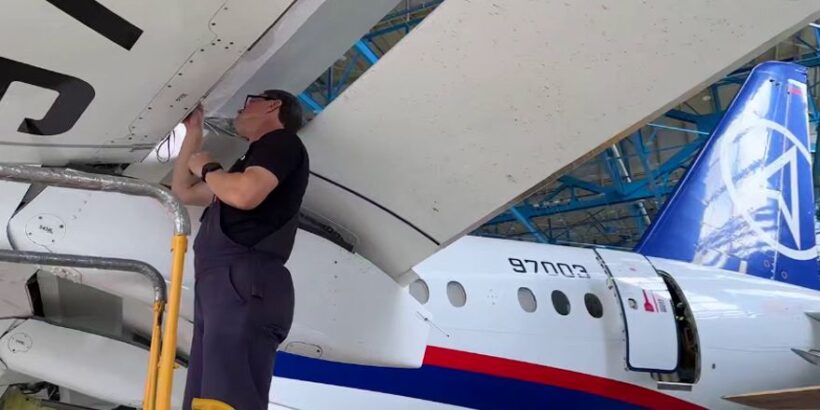A team from the Aerodynamic Performance Department of Yakovlev (formerly Sukhoi Civil Aircraft) and the Central Aerohydrodynamic Institute (TsAGI) will conduct a series of flight experiments to validate computational methods used for determining in-flight wing twist. For this purpose, one of the earliest SSJ100 prototypes (tail number 97003) has been equipped with a distributed system for real-time measurement of wing pressure and deformation. TsAGI developed and supplied all components of this measurement system.
Wing twist refers to the change in angular position of local wing sections relative to the reference plane under aerodynamic loads. The misalignment of the center of pressure, center of rigidity, and center of mass results in complex bending and torsion of the wing. On the SSJ100 testbed, pressure and deformation sensors continuously capture real-time data across all critical spanwise locations, transmitting both local and integrated angular changes to onboard recording devices.
The test program will analyze both geometric and aerodynamic twist. Geometric twist is defined by the variation in airfoil incidence angle along the span, while aerodynamic twist results from changes in airfoil geometry (relative thickness and camber), affecting sectional aerodynamic properties. The primary objective of wing twist is to ensure that, during stall, flow separation initiates last in the aileron regions. This design maintains aileron effectiveness, allowing pilots to retain or regain control in critical situations.
The experiment includes three flights under controlled regimes, featuring turns, level segments, takeoff, landing, and touch-and-go maneuvers with varying weights and center-of-gravity positions. A high-precision camera, operated from a operator’s workstation in the cabin, monitors wing twist throughout the flights.
“The high-precision camera is controlled from the operator’s standard workstation. During each flight regime, the wing undergoes deformation, and the camera records positional changes of reference points,” explained Vladislav Tyurin, Lead Flight Test Engineer at Yakovlev.
According to Tyurin, the deformation measurement system operates autonomously and does not require in-flight intervention. Pressure sensors installed on the wing collect data independently, with continuous recording throughout the flight. After landing, specialists retrieve and analyze the data.
Comparing experimental results with computational models enables refinement of wing stiffness, mass distribution, and aerodynamic parameters. “Validating computational methods reduces the risk of adverse effects related to wing twist and flow separation, and provides designers with critical data to optimize wing structure for required flight performance. The results are integrated into digital models used in the development of new aircraft,” UAC representatives noted.


